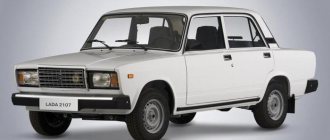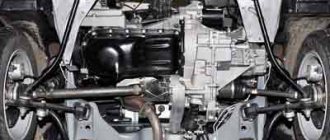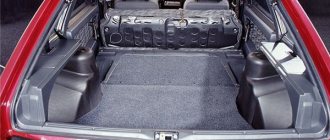At the turn of the 20th-21st centuries, the plant in Tolyatti produced passenger cars, which later received the common name “Lada 110”. The next after this family is considered to be the “Priora”, which received many parts from the “ten” and its own, deeply modernized units with different capabilities and sores. As with earlier or later cars, VAZ did not limit itself to one version. The tenth had modifications, one of which was the VAZ 21103. We will look at the technical characteristics of this car a little later.
This car did not have climate control, an on-board computer and other things included in the basic equipment of a modern car. Nevertheless, it was the first car that looked like a foreign car. The plant still uses this body today, but current machines no longer have digital indices.
Main differences
In addition to bodies, the “ten”, and then the following models, received other innovations. Almost 2110 became the first-born car, like the “penny” in its time. The car received ventilated brakes, galvanized bodywork, a gasoline vapor recovery system, space for air conditioning and other innovations. VAZ 21103, in addition to this, received more powerful heaters and an ABS system. It was possible to order air conditioning and power steering.
But besides this, all 103 cars received injection engines from models 2111-2112 (see picture). Installing this system immediately allowed us to save on fuel. Current VAZs have other sizes, but 21103 is still running, and its owners can easily find information about their car.
Model 21103 - “new” line 110
The VAZ 211103 model is the third modification of the 110 line. The oldest “brother” of this model is the first version of the Lada 2110 with an 8-valve carburetor engine, launched into production in 1996. Then, in the same 1996, the country saw the second modification of the VAZ 21102, which was designed to introduce injection engines into the line. But the number of valves still remained 8. And in 1997, the VAZ 21103 car with a sixteen-valve injection power unit was released.
In addition to the engine, version 21103 has the following innovations compared to its predecessors:
- ABS system;
- air conditioner;
- power steering.
Galvanized body, ventilated brakes, new gasoline vapor recovery system and air-conditioned interior. All these opportunities are real know-how for the Russian automotive industry in 1997. Additional trim levels also included power windows, metallic paint, 14-inch alloy wheels, and even an on-board computer.
Salon and external data
Like the older model, the VAZ 21103 received front-wheel drive, a sedan body, 4 doors, 5 seats. The car could be chosen in three trim levels - “Standard”, “Norma”, or “Lux”. “Standard” was not much different from the base model and is described above. “Norma” - the middle configuration, received electric windows, metallic colors, headrests in the rear seat and velor upholstery, which, according to many users, turned out to be so successful that there was no need to put covers on the seats. The luxury kit received all the features of the average configuration, as well as electric mirrors, fog lights, alloy wheels (14 inches) and an on-board computer (!!!). Also among the little things we can note a slightly improved unit between the front seats and heated front seats.
Based on the VAZ 21103, several more one-piece versions of the executive class appeared. Limousine 21109 “Consul” and stretch sedan (extended sedan) 21108 “Premier”. Both have a partition between the front and rear seats, typical for cars of this class. The Lincoln also has a middle section between the front and rear doors, and the stretch features an extended roof and rear doors, as well as a small window behind them.
We also note that other factories also produced this machine under a VAZ license. This is how armored sedans and even the all-wheel drive 4x4 Lada Tarzan-2 were born. This model is also of interest to tuning studios. About 5 separate tuning kits are produced for it.
Electronic Component Compatibility
Since the controllers were produced by different manufacturers, many of them differ not only technically, but also commutatively:
- They have their own connector that is not compatible with other controllers;
- They differ in the number of contacts and wires;
- They have different mode algorithms (no hardware compatibility);
- Controllers of recent years have built-in switches, while earlier models were built on ignition modules.
In particular, Bosch MP7.0:
- originally created for LADA 110 cars sold in foreign markets;
- has a 55-pin connector;
- does not contain either software or hardware compatibility with other units;
- is able to work after modernization on other types of ECM.
Other controllers such as Bosch M1.5.4, VS 5.1 and January 5.1:
- are software incompatible with each other;
- have different firmware;
- but they can replace each other (in this case the engine operation algorithm will change).
For reference: each controller has its own hardware implementation of the fuel injection algorithm. Most often, one of three is implemented: either simultaneous injection, or phased or pairwise - parallel injection.
Each injection algorithm has its own characteristic features:
- equipped with a special ECU;
- flashed with a specific software version;
- Comes with separate wiring.
Engine parameters
As already written, the injector has become the main difference of the new VAZ 21103. 1.5 16v - characteristics of other engine parameters. Let's decipher them: volume 1.5 liters; 16 valves (versus 8 in the first “ten”); V-shaped pistons.
Additionally, you can indicate that the engine itself has 4 cylinders, 4 valves per cylinder. Note that almost all modern cars now have the same piston arrangement. In the urban driving cycle you will need 8-9 liters per 100 km. Outside the city, consumption does not exceed 6 liters. Since the car is quite old, the engine is designed to refuel AI-92 (some reviews indicate 95). The gas tank volume is 43 liters, the engine power is 93 hp, which gives acceleration to 100 km in 12.5 seconds. Manual gearbox, 5 steps.
Comparison of injection units
The VAZ 21103 operating manual indicates the following engine characteristics.
| Aspects | Options |
| Volume | 1.5 l |
| Maximum power | 94 l. With. (achieved when the crankshaft reaches 5600 rpm.) |
| Limit torque | 130 Nm (possible at 3600 rpm) |
| Number of cylinders | 4 (in-line arrangement) |
| Number of valves | 16 |
| Fuel supply system | Injection |
| Gasoline injection | Distributed |
| Compression ratio | 9,8 |
| Cylinder diameter | 82 mm |
| Piston stroke | 71 mm |
The VAZ 21104 operating manual prescribes parameters slightly different from the above. The engine volume is 100 ml larger and is 1.6 liters. Peak power is 98 hp. With. and is possible already at 5000 rpm. Torque is increased by 1 Nm, but to achieve it, the rotation speed must be increased by 100 rpm. more. The piston stroke has been increased by 4.6 mm, and accordingly the compression ratio has become 0.5 more.
Both the Lada 1103 model and the 1104 version are equipped with 16-valve injection engines.
Other technical data
We looked at the interior configurations and engine capabilities of the VAZ 21103 (1.5 16v). The technical characteristics of other options do not require special decoding, so we will simply rewrite them in a few lines. Trunk volume 450 l. Considering that the cover reaches almost to the bumper itself, and it is possible to fold the rear seats, both standard and long cargo can be placed here. Ground clearance 160 mm. Width 1700 mm, height 1400 mm, length - 4300. Front disc and rear drum brakes. The front suspension is independent McPherson, the rear wheels are slightly recessed, so the front track is 1410 mm, rear - 1380.
VAZ 2110
I continue my entertaining epic on the topic of the wonderful vehicle VAZ-2110. For those who have not read it yet, I suggest you read the treatise dated January 28, 2004, written by a certain Alex. A certain Alex is me and the last essay ends with something like “and I bought a new VAZ-21103 Lux”... let's continue...
The car was purchased on January 21, 2004 at a Moscow car dealership (well, where everything is fair











